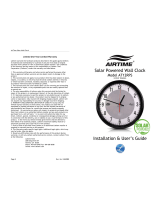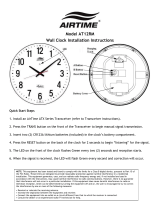
AirTime, Lathem and the Lathem logo are registered trademarks of
Lathem Time Corporation. Other product names mentioned in this
manual may be trademarks of their respective companies and are
hereby acknowledged.
WARNING: Changes or modifications to this product not expressly
approved by the party responsible for compliance could void the user’s
authority to operate this equipment.
FCC:
This equipment has been tested and found to comply with the limits for
a Class A digital device, pursuant to Part 15 of the FCC Rules. These
limits are designed to provide reasonable protection against harmful
interference in a residential installation. This equipment generates,
uses, and can radiate radio frequency energy and, if not installed and
used in accordance with the instructions, may cause harmful
interference to radio communications. However, there is no guarantee
that interference will not occur in a particular installation. If this
equipment does cause harmful interference to radio or television
reception, which can be determined by turning the equipment off and
on, the user is encouraged to try to correct the interference by one or
more of the following measures:
• Reorient or relocate the receiving antenna.
• Increase the separation between the equipment and receiver.
• Connect the equipment into an outlet on a circuit different from that
to which the receiver is connected.
• Consult the dealer or an experienced radio/TV technician for help.
This equipment complies with FCC radiation exposure limits set forth for
an uncontrolled environment. This equipment should be installed and
operated with minimum distance 20cm between the radiator and your
body. This Transceiver must not be co-located or operating in
conjunction with any other antenna or Transceiver.
Copyright © 2009 Lathem Time Corporation. All rights reserved.
Lathem Time Corporation
200 Selig Drive, SW
Atlanta, GA 30336
www.lathem.com
Document Number: USG0070D
Revised 01-17-2012
ATX6 Installation and User Guide
Page 28
Warranty
Limited One-Year Limited Warranty
Lathem warrants the hardware products described in this guide against defects in
material and workmanship for a period of one year from date of original purchase
from Lathem or from an authorized Lathem reseller. The conditions of this warranty
and the extent of the responsibility of Lathem Time Corporation (“Lathem”) under
this warranty are listed below.
1.
This warranty will become void when service performed by anyone other
than an approved Lathem warranty service dealer results in damage to
the product.
2.
This warranty does not apply to any product which has been subject to
abuse, neglect, or accident, or which has had the serial number altered
or removed, or which has been connected, installed, adjusted, or
repaired other than in accordance with instructions furnished by Lathem.
3.
This warranty does not cover dealer labor cost for removing and
reinstalling the machine for repair, or any expendable parts that are
readily replaced due to normal use.
4.
The sole responsibility of Lathem under this warranty shall be limited to
repair of this product, or replacement thereof, at the sole discretion of
Lathem.
5.
If it becomes necessary to send the product or any defective part to
Lathem or any authorized service dealer, the product must be shipped in
its original carton or equivalent, fully insured with shipping charges
prepaid. Lathem will not assume any responsibility for any loss or damage
incurred in shipping.
6.
WARRANTY DISCLAIMER AND LIMITATION OF LIABILITY: Except only the
limited express warranty set forth above, the products are sold with no
expressed or implied warranties of any kind, and the implied warranties
of merchantability and fitness for a particular purpose are hereby
expressly disclaimed. No warranties are given with respect to products
purchased other than from Lathem or an authorized Lathem reseller and
any such products are purchased "as is, with all faults." In no event will
Lathem be liable for any direct, indirect, special, incidental or
consequential damages arising out of or in connection with the delivery,
use or inability to use, or performance of this product. In the event any
limited remedy given herein shall be deemed to have failed of its
essential purpose, Lathem's maximum liability shall be to refund the
purchase price upon return of the product.
7.
Proof of date of purchase from Lathem or an authorized Lathem reseller
is required for warranty service on this product.
8.
This Warranty grants specific legal rights. Additional legal rights, which
may vary by locale, may also apply.
9.
Should any difficulties arise with the performance of this product during
warranty, or with any Lathem authorized service centers, contact Lathem
Time at the address below.
Lathem Time
200 Selig Drive, SW, Atlanta, GA 30336
404-691-0405
www.lathem.com


















